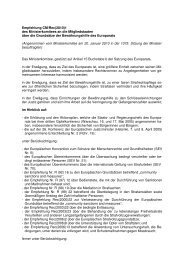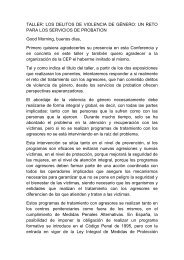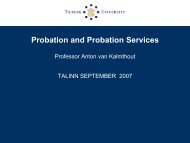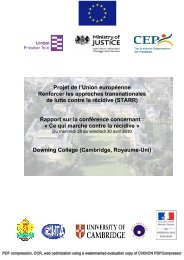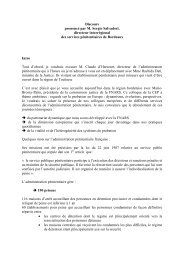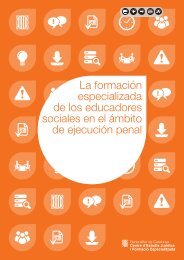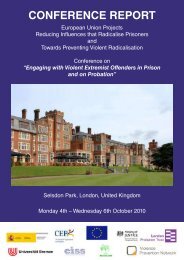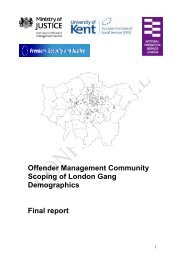Monitoring Hate Crime - CEP, the European Organisation for ...
Monitoring Hate Crime - CEP, the European Organisation for ...
Monitoring Hate Crime - CEP, the European Organisation for ...
Create successful ePaper yourself
Turn your PDF publications into a flip-book with our unique Google optimized e-Paper software.
<strong>Monitoring</strong> <strong>Hate</strong> <strong>Crime</strong> and Some Comparative Law Annotations<br />
Dr. iur. Irene Sagel-Grande, LLM<br />
University of Groningen, The Ne<strong>the</strong>rlands<br />
1. Introduction<br />
Since my short essay on “<strong>Hate</strong> <strong>Crime</strong>, Comparative Law Annotations” was written in <strong>the</strong><br />
framework of <strong>the</strong> EU AGIS Programme in 2006 1 , several new studies were published that<br />
improved our knowledge about “hate crime”. Some of <strong>the</strong>se publications also complemented<br />
my essay. There<strong>for</strong>e <strong>the</strong> aim of my contribution of today is not to look back to <strong>the</strong> 2006 essay,<br />
but to discuss three fundamental questions of importance <strong>for</strong> fur<strong>the</strong>r studies and research in<br />
<strong>the</strong> perspective of some new findings: <strong>the</strong> concepts of “hate crime” and “criminal<br />
discrimination”, research results on criminal discrimination and legal diversity in <strong>the</strong><br />
<strong>European</strong> Union. Concerning recent research results I am confining to some Dutch<br />
publications of <strong>the</strong> period 2005 - 2008.<br />
2. What is <strong>Hate</strong> <strong>Crime</strong><br />
The term “hate crime” was developed in <strong>the</strong> United States of America where it is juridical<br />
relevant. Meanwhile this term is in use in Europe too. In England it is often used instead of<br />
<strong>the</strong> official term “racially aggravated offences” 2 , in Germany one is talking about<br />
“Hasskriminalität” and in <strong>the</strong> Ne<strong>the</strong>rlands <strong>the</strong> English word itself was introduced into Dutch<br />
language. The question, however is, whe<strong>the</strong>r we should make use of <strong>the</strong> term “hate crime” on<br />
<strong>the</strong> continent.<br />
The US Congress defined a hate crime as a crime in which “<strong>the</strong> defendant’s conduct was<br />
motivated by hatred, bias or prejudice, based on <strong>the</strong> actual or perceived race, colour, religion,<br />
national origin, ethnicity, gender, sexual orientation or gender identity of ano<strong>the</strong>r individual<br />
or group of individuals”. Later disability was added to <strong>the</strong> list.<br />
Speaking in criminal law terms most offences defined by Penal Codes or in case law can be<br />
categorized as “hate crimes” if motivated by hatred:<br />
1 Irene Sagel-Grande, <strong>Hate</strong> <strong>Crime</strong>. Comparative Law Annotations, Groningen University 2006, ISBN 90-367-<br />
2743-X.<br />
2 <strong>Crime</strong> and Disorder Act 1998, Part II, Art. 28-36.<br />
1
Murder or homicide as well as bodily injury, damage of property, offensive graffiti, insult,<br />
intimidation, vandalism, obscene telephone calls etc. Victim of “hate crimes” can be a person,<br />
a group of persons, an organisation, a state or religious institutions. 3<br />
All “hate crime” consists of criminalized acts or omissions that become “hate crimes” by <strong>the</strong><br />
subjective motivation of <strong>the</strong> offender only and it is just <strong>the</strong> motivation of <strong>the</strong> offender that is<br />
generally so extremely difficult to recognize and to prove. Only in some cases circumstantial<br />
evidence will make <strong>the</strong> offender’s intent obvious.<br />
Often a background investigation of <strong>the</strong> accused or eyewitness reports of <strong>the</strong> crime are <strong>the</strong><br />
only means to detect <strong>the</strong> offender’s intent. That is even more a weak basis as legislators in<br />
some countries (United States of America, England and Belgium) are convinced that if an<br />
offence was motivated by hatred it is automatically a qualified offence that must be punished<br />
with more hardship than ordinary offences. But is it correct indeed, to reproach somebody<br />
extra <strong>for</strong> his or her motives In literature and by practice <strong>the</strong>re are different answers given to<br />
this question in Europe. In <strong>the</strong> absence of clear definitions and common criteria about what<br />
<strong>the</strong> motives must be like to qualify an ordinary offence to become a hate crime a lot of doubts<br />
and uncertainties arise. Fur<strong>the</strong>rmore subjective motives are judged by <strong>the</strong> subjective opinions<br />
of <strong>the</strong> police and <strong>the</strong> public prosecutors 4 who have to decide whe<strong>the</strong>r <strong>the</strong> offence committed<br />
was a “hate crime” or not. The “hate crime concept” cannot offer legal certainty 5 and thus it<br />
is not in con<strong>for</strong>mity with <strong>the</strong> principle of legality. 6 Obviously this is a major problem and an<br />
argument against adopting <strong>the</strong> term “hate crime”.<br />
The importance of this avoidance is stressed by <strong>the</strong> not less important circumstance that <strong>the</strong><br />
term “hate crime” points so strongly in <strong>the</strong> direction of ra<strong>the</strong>r spectacular incidents of violent<br />
crime. In reality however, <strong>the</strong>re is a high number of not at all spectacular discriminatory<br />
offences disturbing public peace as well as <strong>the</strong> well-being of those becoming victims of<br />
criminal and o<strong>the</strong>r discrimination, while <strong>the</strong> extent of intense racist violence and crime is<br />
according to empirical research relatively moderate. 7<br />
The considerable difference between <strong>the</strong> American hate crime concept and our criminal<br />
discrimination concept is <strong>the</strong> result of <strong>the</strong> fact that in America <strong>the</strong> importance given to<br />
freedom of speech does not allow <strong>the</strong> creation of something like our concept of specific<br />
3 See <strong>for</strong> example 422.6 Cali<strong>for</strong>nia Penal Code<br />
4 Ch. Brants, R. Kool, A. Rignalda, Strafbare discriminatie, Willem Pompe Instituut voor Strafrechtspleging,<br />
Universiteit Utrecht; WODC, Ministerie van Justitie, 2007, p. 240.<br />
5 Rechtssicherheit.<br />
6 Ch. Brants, R. Kool, A. Rignalda, Strafbare discriminatie, Willem Pompe Instituut voor Strafrechtspleging,<br />
UU, WODC, Ministerie van Justitie, 2007, p. 239.<br />
7 Ch. Brants, R. Kool, A. Rignalda, WODC, Ministerie van Justitie, Strafbare discriminatie, p. 246.<br />
2
criminal discrimination. There must happen spectacular incidents indeed, be<strong>for</strong>e <strong>the</strong> freedom<br />
of speech can be affected, may it just be indirectly.<br />
There is also a third reason pleading against <strong>the</strong> term “hate crime” namely <strong>the</strong> inevitable<br />
relation of reactions and actions. In <strong>the</strong> case of “hate crime” <strong>the</strong> term suggests something<br />
extraordinary mean and wrong and automatically causes a subconscious urge to use<br />
corresponding reactions that can easily be overreactions. The risk of overreaction might not<br />
be extremely high in prosecuting and sentencing, but possibly in connection with detecting<br />
activities by <strong>the</strong> police and even more in reporting about “hate crime” in <strong>the</strong> media. The last<br />
being of great influence on public opinion and able to cause unrealistic, eventually even very<br />
exaggerated views that can bring on commotion, feelings of insecurity and hostility against<br />
certain groups in society. These emotions can also result in aggression and violence, perhaps<br />
also in feeling <strong>the</strong> need of making one’s own justice, all reactions that are a threat <strong>for</strong><br />
community life and <strong>the</strong>re<strong>for</strong>e must be prevented.<br />
In <strong>the</strong> title of this paper I con<strong>for</strong>med with <strong>the</strong> title of this conference, although I am convinced<br />
that it is more adequate and not only from a legal, but also from a psychological point of view<br />
better to use <strong>the</strong> term “criminal discrimination” instead of <strong>the</strong> term “hate crime”.<br />
3. What is Criminal Discrimination<br />
3.1 Criminal Discrimination as defined by <strong>the</strong> Dutch Penal Code<br />
In <strong>the</strong> Dutch Penal Code several important terms are defined in <strong>the</strong> Art. 78 – Art. 90octies.<br />
Art. 90quater explains what <strong>the</strong> meaning of “discrimination” is. It reads as follows:<br />
“Discrimination or to discriminate must be understood as every kind of distinction, every<br />
exclusion, restriction or preference that has <strong>the</strong> aim or can have <strong>the</strong> consequence that <strong>the</strong><br />
recognition, <strong>the</strong> use or <strong>the</strong> practice on equal terms of human rights and fundamental political,<br />
economic, social or cultural freedoms or of liberties in o<strong>the</strong>r fields of social life is, undone or<br />
affected” (Art. 137c – Art. 137g , Art. 429 quarter Dutch Penal Code). 8<br />
In <strong>the</strong> Art. 137c – Art. 137g mainly <strong>the</strong> following is criminalized:<br />
8 Art. 90quater:<br />
“Onder discriminatie of discrimineren wordt verstaan elke vorm van onderscheid, elke uitsluiting, beperking of<br />
voorkeur, die ten doel heeft of ten gevolg kan hebben dat de erkenning, het genot of de uitoefening op voet van<br />
gelijkheid van de rechten van de mens en de fundamentele vrijheden op politiek, economisch, sociaal of<br />
cultureel terrein of op andere terreinen van het maatschappelijke leven, wordt teniet gedaan of aangetast.”<br />
3
1. Insulting a group of people because of <strong>the</strong>ir race, religion, philosophy of life, <strong>the</strong>ir<br />
hetero- or homosexual nature or <strong>the</strong>ir bodily, psychical or intellectual handicap, Art.<br />
137c Dutch Penal Code.<br />
2. Inciting to hatred or discrimination of people or acting violently against people<br />
because of <strong>the</strong>ir race, religion or philosophy of life, <strong>the</strong>ir gender, <strong>the</strong>ir hetero- or<br />
homosexual nature or <strong>the</strong>ir bodily, psychical or intellectual handicap, Art. 137d Dutch<br />
Penal Code.<br />
3. Making public insulting utterances, not <strong>for</strong> realistic in<strong>for</strong>mation, Art. 137e Dutch<br />
Penal Code.<br />
4. Support of discriminative activities, Art. 137f Dutch Penal Code.<br />
5. Discrimination in connection with practising a profession or an office, Art. 137g<br />
Dutch Penal Code.<br />
6. Discriminating while practising official duties, Art. 429quater Dutch Penal Code.<br />
Since some years, in <strong>the</strong> cases of Art. 137c and d <strong>the</strong> maximum prison sentence can be 2<br />
years, in cases of Art. 137e and g one year and in cases of Art. 137f Dutch Penal Code 3<br />
months. 9 In all cases falling under <strong>the</strong> Art. 137c-g instead of a prison sentence a fine can be<br />
imposed, <strong>the</strong> maximum being a fine of <strong>the</strong> <strong>for</strong>th category <strong>for</strong> <strong>the</strong> more serious offences, what<br />
means 16. 750 Euro, Art. 23 Dutch Penal Code. There do not exist special sentencing minima<br />
in <strong>the</strong> Ne<strong>the</strong>rlands. The general minimum <strong>for</strong> prison sentences <strong>for</strong> a certain time is one day<br />
<strong>for</strong> all offences and <strong>for</strong> fines it is 3 Euro. In consequence of <strong>the</strong>se sentencing rules <strong>the</strong><br />
freedom <strong>for</strong> decision making of <strong>the</strong> Dutch judge is ra<strong>the</strong>r great.<br />
Since <strong>the</strong> Instruction ‘Discrimination’ and <strong>the</strong> Guideline ‘Criminal proceeding in cases of<br />
criminal discrimination’ of <strong>the</strong> Five Attorneys General 10 came into <strong>for</strong>ce some years ago<br />
prosecution on <strong>the</strong>se cases was intensified. In certain, in <strong>the</strong> guideline precisely summarized,<br />
serious cases <strong>for</strong> example <strong>the</strong> public prosecutors are now obliged to demand a 25% higher<br />
penalty. Fur<strong>the</strong>rmore, <strong>the</strong>re were specialized public prosecutors appointed and two national<br />
centres founded where expertise on discrimination problems is ga<strong>the</strong>red.<br />
9 Act of Parliament of 20 XI 2003, Staatsblad 2003, 480.<br />
10 Richtlijn voor stafvordering discriminatie, Staatscourant 2000, 63 and 2003,61, Aanwijzing discriminatie,<br />
Staatscourant 2003, 61. A new Instruction is about to be prepared.<br />
4
Although <strong>the</strong> maxima of <strong>the</strong> sentences <strong>for</strong> specific discrimination were extended only some<br />
years ago, <strong>the</strong> need of fur<strong>the</strong>r raising was under discussion in Parliament and also in public<br />
again recently.<br />
3.2 Specific and common criminal discrimination<br />
In <strong>the</strong> Ne<strong>the</strong>rlands one differentiates between specific and common criminal discrimination.<br />
Specific criminal discrimination are discriminatory utterances or o<strong>the</strong>r expressions<br />
specifically criminalised in <strong>the</strong> Dutch Penal Code. 11 In cases of specific criminal<br />
discrimination punishability derives from <strong>the</strong> objectively discriminative content or effect of a<br />
certain uttering or o<strong>the</strong>r behaviour. With <strong>the</strong> term common criminal discrimination those<br />
offences are characterised that are criminal offences not being discriminatory as such but that<br />
can get a discriminatory character by <strong>the</strong> offender’s motives.<br />
Criminalisation in <strong>the</strong>se cases is based on <strong>the</strong> offence committed, <strong>for</strong> example bodily injury or<br />
arson. If any criminal offence resulted from <strong>the</strong> offender’s discriminatory motives, <strong>the</strong> offence<br />
gets additionally an discriminatory aspect in <strong>the</strong> view of o<strong>the</strong>rs. Thus we can conclude that<br />
“common criminal discrimination” is constructed in <strong>the</strong> same way as “hate crime” and<br />
<strong>the</strong>re<strong>for</strong>e both have <strong>the</strong> same problems. They are both difficult to recognize in <strong>the</strong>ir<br />
subjectivity and <strong>the</strong>y are both missing a clear concept that offers certainty.<br />
At present <strong>the</strong> police is obliged to register and conduct a police search in <strong>the</strong> cases of special<br />
discrimination that came to <strong>the</strong>ir attention.<br />
3.3 <strong>Monitoring</strong> criminal discrimination<br />
A consequence of <strong>the</strong> difference between specific and common criminal discrimination until<br />
now is that in <strong>the</strong> Ne<strong>the</strong>rlands only specific criminal discrimination is registered regularly<br />
while cases of common criminal discrimination are not registered separately but only as<br />
offences penalised in <strong>the</strong> Penal Code, <strong>the</strong>ir additional discriminative aspects being registered<br />
only exceptionally. There are plans to change this soon.<br />
A Dutch Monitor on Racism and Extremism is published in <strong>the</strong> Ne<strong>the</strong>rlands since several<br />
years. 12 It is collecting in<strong>for</strong>mation about racist violence in <strong>the</strong> Ne<strong>the</strong>rlands. Some of <strong>the</strong>se<br />
11 See <strong>the</strong> Art. 137c – Art. 137g Dutch Penal Code.<br />
12 J. van Donselaar, P.R. Rodrigues, <strong>Monitoring</strong> racisme and extremisme, 7 e rapportage, Anne Frank Stichting,<br />
Amsterdam, Universiteit Leiden, Department Bestuurskunde, Leiden, 2007.<br />
5
cases registered might belong to <strong>the</strong> category of criminal discrimination, but <strong>the</strong> definitions<br />
used in <strong>the</strong> Monitor on Racism and Extremism are not always <strong>the</strong> legal definitions. That<br />
makes it difficult, perhaps even impossible, to use <strong>the</strong> data of this Monitor toge<strong>the</strong>r with <strong>the</strong><br />
data registered in connection with prosecuting and sentencing specific criminal<br />
discrimination. 13<br />
3.4 Recent Dutch research on criminal discrimination<br />
3.4.1 Introduction<br />
In <strong>the</strong> Ne<strong>the</strong>rlands research on criminal discrimination took place recently covering <strong>the</strong> period<br />
2000 – 2005. 14 It was initiated by <strong>the</strong> Dutch Permanent Parliamentary Committee on Justice<br />
in 2006 that wanted to be in<strong>for</strong>med on <strong>the</strong> use of criminal law in <strong>the</strong> fight against<br />
discrimination and on <strong>the</strong> question whe<strong>the</strong>r present sentences were high enough and effective.<br />
The research tried to determine in which way <strong>the</strong> Department of Public Prosecution and <strong>the</strong><br />
courts dealt with cases of criminal discrimination.<br />
For what concerns specific criminal discrimination all data registered in <strong>the</strong> Ne<strong>the</strong>rlands<br />
between 2000 and 2005 were analysed in this research. There<strong>for</strong>e principally <strong>the</strong> research<br />
result answers <strong>the</strong> quantitative question of “how often was a certain decision taken” <strong>for</strong> <strong>the</strong><br />
whole country.<br />
Never<strong>the</strong>less <strong>the</strong> fact that <strong>the</strong>re were only relatively few cases registered makes it probable<br />
that <strong>the</strong> dark number of cases is high and consequently <strong>the</strong>re exist certain reserves about <strong>the</strong><br />
representativeness of <strong>the</strong> cases that came to <strong>the</strong> attention of <strong>the</strong> police.<br />
In <strong>the</strong> field of common criminal discrimination <strong>the</strong> lack of data is even greater. Accordingly<br />
<strong>the</strong> research could only be based on 91 case studies. That means <strong>the</strong> results cannot offer more<br />
than a first impression of what is reality in this field.<br />
3.4.2 Some results of <strong>the</strong> research on specific criminal discrimination<br />
Between 2000 and 2005, <strong>the</strong> Dutch Public Prosecution Service issued 803 summonses – on<br />
average 58% of <strong>the</strong> 1.453 specific discrimination offences that came to <strong>the</strong> attention of <strong>the</strong><br />
13 Ch. Brants, R. Kool, A. Rignalda, Strafbare discriminatie, WODC 2007, p. 213.<br />
14 Ch. Brants, R. Kool, A. Rignalda, Strafbare discriminatie, see above, 2007.<br />
6
prosecutors during <strong>the</strong> research period. On average, <strong>the</strong> prosecution was dropped in a good<br />
20% of cases, and 16% were settled out of court by means of a prosecutor’s fine (transaction).<br />
To illustrate <strong>the</strong> meaning of <strong>the</strong>se data we relate <strong>the</strong> number of specific discrimination cases<br />
of one year to <strong>the</strong> total number of criminal law cases that came to <strong>the</strong> attention of <strong>the</strong> Public<br />
Prosecutor Service during <strong>the</strong> same year. In 2004 this were 273.974 cases, 141 of which or<br />
0,05 % being specific discrimination cases. 15<br />
According to <strong>the</strong> registered data each year between 2000 and 2005, Dutch courts convicted in<br />
between 93 and 118 specific discrimination cases, with on average about 9% overall<br />
acquittals. 16<br />
The total number of cases settled by <strong>the</strong> Dutch district courts in 2004 was 133.218 Penal Law<br />
cases, only 48 of <strong>the</strong>m or 0,04% being specific discrimination cases. 17<br />
Most of all kind of cases take place on <strong>the</strong> street or in <strong>the</strong> neighbourhood. Focusing on <strong>the</strong><br />
offences <strong>the</strong> research resulted in <strong>the</strong> following:<br />
54% of <strong>the</strong> cases were verbal discriminations, in 30% of <strong>the</strong> cases aggression was involved, in<br />
about 4-5% of <strong>the</strong> cases vandalism and property offences. 18<br />
2/3 of <strong>the</strong> verbal discriminations were committed individually and one third toge<strong>the</strong>r with<br />
o<strong>the</strong>rs.<br />
When violence played a role twice as many cases were committed with a group than<br />
individually. 19<br />
52% of <strong>the</strong> offenders did not use alcoholics or drugs, 41% were under influence of alcoholics,<br />
4% of drugs and 4% of both. 20<br />
There were three main reasons <strong>for</strong> discrimination found: In 29% of <strong>the</strong> cases Turkish or<br />
Arabian ethnicity was decisive, in 23% <strong>the</strong> colour and in 22% anti-Semitism. The Islam was<br />
only registered as reason in 4% and religion in 3% of <strong>the</strong> cases. 21<br />
15 N.E. de Lange, A.M. van der Laan, S. Bogaerts, Vervolging en berechting in: W. van der Heide, A.Th.J.<br />
Eggen, Criminaliteit en rechtshandhaving 2006, Onderzoek en beleid 255, Boon, CBS, WODC 2007, p. 421.<br />
16 Ch. Brants, R. Kool, A. Rignalda, Strafbare discriminatie, WODC 2007, p. 247.<br />
17 N.E. de Lange, A.M. van der Laan, S. Bogaerts, Vervolging en berechting in: W. van der Heide, A.Th.J.<br />
Eggen, Criminaliteit en rechtshandhaving 2006, Boon, CBS, WODC 2007, p. 432.<br />
18 Ch. Brants, R. Kool, A. Rignalda, Strafbare discriminatie, WODC 2007, p. 274.<br />
19 Ch. Brants, R. Kool, A. Rignalda, Strafbare discriminatie, WODC 2007, p. 300.<br />
20 Ch. Brants, R. Kool, A. Rignalda, Strafbare discriminatie WODC 2007, p. 302.<br />
21 Ch. Brants, R. Kool, A. Rignalda, Strafbare discriminatie, WODC 2007, p. 303.<br />
7
81% of <strong>the</strong> offenders were autochthones, 16% not Western allochthones and 3% Western<br />
allochthones. 10% of <strong>the</strong> offenders were women. 55% of <strong>the</strong> offenders were between 18 and<br />
35 years of age. With growing age <strong>the</strong> number of discriminatory offences decreased. 22<br />
The finding that offenders discriminating <strong>for</strong> reasons of anti-Semitism are relatively very<br />
young is striking: 68% of <strong>the</strong>se offenders were 12-25 years of age, more than half of <strong>the</strong>m<br />
belonging to <strong>the</strong> age group of those 12-17 years of age. 23<br />
Ano<strong>the</strong>r interesting research question was, in how far <strong>the</strong> offenders are acting from<br />
conviction.<br />
Little more aggressive offenders were acting without conviction than from conviction (30%<br />
versus 26%).<br />
Those acting without conviction primarily are committing verbal discrimination. Offenders<br />
acting from conviction relatively often are committing daub.<br />
Offenders discriminating from conviction are using less alcoholics, relatively seldom (4%)<br />
drugs and more often no psychotropic substances (71%) than <strong>the</strong> offenders who do not act<br />
from conviction (49%). 24<br />
Looking at <strong>the</strong> sentencing practice fines and task penalties (community service orders) are <strong>the</strong><br />
most frequently used sanctions. Of <strong>the</strong> 948 cases 41,8 % ended with a fine and 25,4% with a<br />
task penalty. If discriminative offences were combined with aggression or serious aggression<br />
(offences with threat of life) <strong>the</strong> offenders were in most cases sentenced to prison sentences:<br />
in 1,7% of <strong>the</strong> 948 settled cases to a sentence of 6 months or less and in 6,5% of all settled<br />
cases to a sentence of more than 6 months. 25<br />
In 70% of cases of specific discrimination <strong>the</strong> prosecution was founded only on <strong>the</strong><br />
discriminatory offence.<br />
The results generally show that specific criminal discrimination as far as it came to <strong>the</strong><br />
attention of <strong>the</strong> Public Prosecution Service is likely to be nei<strong>the</strong>r in quantity nor in quality<br />
very serious. However, what we know until now is only a little part of reality. Perhaps <strong>for</strong> this<br />
reason most research findings arouse our curiosity.<br />
3.4.3 Some results from <strong>the</strong> study on common criminal discrimination<br />
22 Ch. Brants, R. Kool, A. Rignalda, Strafbare discriminatie, WODC 2007, p. 304.<br />
23 Ch. Brants, R. Kool, A. Rignalda, Strafbare discriminatie, WODC 2007, p. 305.<br />
24 Ch. Brants, R. Kool, A. Rignalda, Strafbare discriminatie, WODC 2007, p. 306.<br />
25 Ch. Brants, R. Kool, A. Rignalda, Strafbare discriminatie, WODC 2007, p. 274.<br />
8
3.4.3.1 Introduction<br />
As already stated be<strong>for</strong>e, common criminal discrimination appears in committing offences of<br />
all kind, <strong>the</strong> victim being somebody hated or belonging to a group of people disdained. Till<br />
now in <strong>the</strong> Ne<strong>the</strong>rlands <strong>the</strong>re is no clear definition of common criminal discrimination<br />
<strong>for</strong>mulated. In <strong>the</strong> discussion with representatives of <strong>the</strong> police, <strong>the</strong> public prosecution service<br />
and <strong>the</strong> judges during <strong>the</strong> so-called scenario conference, being part of <strong>the</strong> research on criminal<br />
discrimination, this lack of definition resulted in a wide diversity of opinions about <strong>the</strong> scope<br />
of this group of offences. The opinions were not only differing between <strong>the</strong> three professional<br />
groups, but also within <strong>the</strong> groups <strong>the</strong>mselves.<br />
As already stated be<strong>for</strong>e, <strong>for</strong> continental jurists it is a problem to accept a subjective motive as<br />
element of an offence, those principally being facts. Fur<strong>the</strong>rmore continental jurists are not<br />
trained to use subjective elements in practice as <strong>the</strong>se do not really belong to <strong>the</strong>ir legal<br />
system.<br />
There<strong>for</strong>e, summarizing we can say that <strong>the</strong> phenomenon ‘common criminal discrimination’<br />
is not legally structured, can hardly be identified by facts, must be recognized mainly<br />
intuitionally and is extremely difficult to prove. It depends on subjective beliefs of <strong>the</strong><br />
offender as well as on subjective observations and insights of <strong>the</strong> those who have to detect, to<br />
prosecute and to judge. Cases of common criminal discrimination in this way are surrounded<br />
by a great deal of uncertainties.<br />
3.4.3.2 Some findings of <strong>the</strong> research on common criminal discrimination 26<br />
Common discrimination is in most cases (96%) committed by violence against a person<br />
(54%) or by threat of violence against a person (42% of all cases). The offences of common<br />
discrimination are committed more often (42%) in a group than offences of specific<br />
discrimination (26%).<br />
The places where common criminal discrimination primarily is committed are, as in <strong>the</strong> case<br />
of special criminal discrimination, <strong>the</strong> street and <strong>the</strong> neighbourhood. A third place is <strong>the</strong><br />
catering industry. In specific and common discrimination cases <strong>the</strong> victim does contribute<br />
only seldom, namely in 10% of <strong>the</strong> cases.<br />
26 Ch. Brants, R. Kool, A. Rignalda, Strafbare discriminatie, WODC 2007, p. 311, 312.<br />
9
There is more use of psychotropic substances found in connection with common<br />
discrimination (65%) found than with specific discrimination (48%). The difference being<br />
mainly more use of alcoholics (common discrimination: 57% , specific discrimination: 41%).<br />
The use of alcoholics fits in with <strong>the</strong> offences committed: 42% of those committing violence<br />
against persons, 33% committing threat and 22% committing maltreatment (assault) had<br />
drunk alcoholics.<br />
These findings give a first impression about <strong>the</strong> kind of common discrimination cases<br />
sentenced in <strong>the</strong> Ne<strong>the</strong>rlands and it becomes obvious that <strong>the</strong>y belong to a category in which<br />
<strong>the</strong> facts, namely aggression, are decisive <strong>for</strong> prosecution and sentencing and not so much <strong>the</strong><br />
mental attitude of <strong>the</strong> offender. This finding points into <strong>the</strong> direction that <strong>the</strong> Public<br />
Prosecution Service and <strong>the</strong> judges are generally keeping in line with <strong>the</strong> continental law<br />
principals; <strong>the</strong>y do not tend into <strong>the</strong> direction of <strong>the</strong> American “hate crime concept” but<br />
prefer to leave <strong>the</strong> decision, whe<strong>the</strong>r or not sharper sentencing is necessary in connection with<br />
<strong>the</strong> discriminative motives that were at <strong>the</strong> basis of <strong>the</strong> individual offence in question, to <strong>the</strong><br />
discretion of <strong>the</strong> judges and <strong>the</strong>ir assessment of penalty.<br />
3.4.4 Need of continuous monitoring<br />
The findings of <strong>the</strong> Dutch research are a start in <strong>the</strong> direction of exploring criminal<br />
discrimination in several perspectives. They in<strong>for</strong>m us <strong>for</strong> <strong>the</strong> first time in some measure<br />
about what is happening in this field in prosecutorial and court practice. This kind of research<br />
should be continued and extended. Only regular monitoring of criminal discrimination is a<br />
guarantee that we are able to develop adequate means to prevent and repress discrimination<br />
successfully. To know whe<strong>the</strong>r our ef<strong>for</strong>ts are effective we also need a monitor that<br />
continuously is watching <strong>the</strong> effectiveness of our practice. Regular monitoring and research<br />
have to be <strong>the</strong> fundament of legal policies and law making and of prosecution and sentencing<br />
guidelines. Fur<strong>the</strong>rmore it can serve as a review medium of research and fieldwork.<br />
Fur<strong>the</strong>r research can help to improve our knowledge about <strong>the</strong> quantity and quality of both,<br />
common and specific criminal discrimination. Future research should focus in <strong>the</strong> first place<br />
on <strong>the</strong> dark number of <strong>the</strong>se offences that might be ra<strong>the</strong>r high. English research that<br />
emphatically and successfully stimulated <strong>the</strong> police to register in<strong>for</strong>mation that victims and<br />
10
third persons lay with it, resulted in a strong increase of registered cases, not necessarily of<br />
<strong>the</strong> number of convictions. 27<br />
At present criminal discrimination cases often are not suitable <strong>for</strong> a criminal charge as <strong>the</strong><br />
public prosecutor is not able to substantiate <strong>the</strong> facts and, what is even more difficult, <strong>the</strong><br />
motives. In <strong>the</strong> few cases that come to court <strong>the</strong> sentences are relatively often lower than <strong>the</strong><br />
prosecutor’s demand <strong>for</strong> a penalty. 28<br />
Regular monitoring might perhaps lead us to a better understanding of <strong>the</strong> connections<br />
between <strong>the</strong>se facts and give clues <strong>for</strong> adequate management.<br />
3.4.5 Necessity to raise <strong>the</strong> maxima of penalties <strong>for</strong> criminal discrimination in <strong>the</strong> Dutch<br />
Penal Code<br />
The Dutch research on criminal discrimination also had to find an answer to <strong>the</strong> question<br />
whe<strong>the</strong>r <strong>the</strong> Dutch Penal Code should be amended once more within a short lapse of time to<br />
create <strong>the</strong> possibility of inflicting harsher punishments <strong>for</strong> discriminatory offences. 29<br />
Considering <strong>the</strong> main pros and cons one came to <strong>the</strong> conclusion that it is nei<strong>the</strong>r necessary to<br />
introduce higher maxima <strong>for</strong> specific criminal discrimination again, nor to introduce a special<br />
regulation that offers <strong>the</strong> possibility of higher sanctions in cases any offence was committed<br />
on <strong>the</strong> basis of discriminatory motives. The Dutch Penal Code offers already enough<br />
possibilities <strong>for</strong> adequate sentencing. But, as <strong>the</strong> empirical research proved, until now <strong>the</strong>se<br />
possibilities are not at all used to <strong>the</strong>ir full extent in practice.<br />
The Dutch Minister of Justice subscribes to this view and does not plan to change <strong>the</strong> law <strong>for</strong><br />
so far.<br />
3.4.6. Consequences of <strong>the</strong> research <strong>for</strong> criminal policies<br />
In his reaction on <strong>the</strong> report on “Criminal Discrimination” <strong>the</strong> Dutch Minister of Justice<br />
stressed 30 that <strong>the</strong>re must be respect <strong>for</strong> everybody in society. Discrimination injures <strong>the</strong><br />
principles of <strong>the</strong> constitutional state and must be tackled by preventive and repressive<br />
measures. Fur<strong>the</strong>rmore he wrote in his letter addressed to parliament, that he is about to<br />
27 Home Office, Race and <strong>the</strong> Criminal Justice System, An Overview of <strong>the</strong> Complete Statistics 2004-2005,<br />
2006: www.homeoffice.gov.uk<br />
28 Ministry of Justice, Nieuwsbericht of 10 January 2008, www.minjus.nl/actueel/nieuwsberichten<br />
29 Ch. Brants, R. Kool, A. Ringnalda, Strafbare Discriminatie, WODC 2007, p. 219.<br />
30 Letter of 20 December 2007, Beleidsreactie WODC onderzoek Strafbare discriminatie.<br />
11
improve <strong>the</strong> methods of registration of and criminal policy on criminal discrimination, <strong>the</strong><br />
main means being:<br />
firstly a better cooperation of <strong>the</strong> partners, i.e. <strong>the</strong> police, <strong>the</strong> Department of Public<br />
Prosecution, <strong>the</strong> local councils and <strong>the</strong> antidiscrimination bureaus,<br />
secondly a new common “Instruction Discrimination” (Aanwijzing Discriminatie) and<br />
thirdly ga<strong>the</strong>ring more in<strong>for</strong>mation on discrimination that takes place on internet.<br />
4. Some Comparative Law Annotations<br />
Above, in connection with <strong>the</strong> presentation of <strong>the</strong> subjects “hate crime” and “criminal<br />
discrimination” we already talked about <strong>the</strong> important differences between <strong>the</strong> continental, <strong>the</strong><br />
American and to a somewhat lesser extent, <strong>the</strong> English legal system, most important<br />
difference being in <strong>the</strong> understanding of <strong>the</strong> principle of legality in <strong>the</strong> sense of nullum crimen<br />
sine lege, (no crime without a statutory regulation) and nulla poena sine lege, (no sentencing<br />
without a statutory regulation). Most differences between <strong>the</strong> legal families have historical<br />
reasons. Our principle of legality derived as <strong>the</strong> Latin words already made obvious, from<br />
Roman law. The extent of <strong>the</strong> Roman law influence on <strong>the</strong> different legal systems of <strong>the</strong><br />
world is until our times one of <strong>the</strong> main reasons <strong>for</strong> <strong>the</strong> existing differences. Mainly <strong>for</strong><br />
political reasons <strong>the</strong> influence of Roman law on <strong>the</strong> development of German law was more<br />
intensive than in o<strong>the</strong>r countries. In connection with this fact we should, here in Berlin, think<br />
<strong>for</strong> a moment of one of <strong>the</strong> greatest German law professors, Friedrich Carl von Savigny<br />
(1779-1861), who worked in this town, however in <strong>the</strong> field of private law. Speaking in<br />
modern terms von Savigny was a “great fan of Roman law” and <strong>the</strong> influence of his<br />
outstanding work on <strong>the</strong> German Civil Code resulted in <strong>the</strong> fact that German private law still<br />
in our days is so strongly related to Roman law. Here we have one example to show how<br />
differences between legal systems can come to existence by chance. The reasons <strong>for</strong> <strong>the</strong><br />
differences between <strong>the</strong> regulations of specific discrimination also mainly have historical<br />
backgrounds and <strong>the</strong>y are so great that it is hardly possible to compare <strong>the</strong> regulations of<br />
various countries in a satisfying way. The same is true <strong>for</strong> <strong>the</strong> specific regulations on<br />
blasphemy and <strong>the</strong> spreading of blasphemous writings regulated <strong>for</strong> example in <strong>the</strong> Art. 147<br />
12
and 147a Dutch Penal Code, religion-related discriminatory offences that should also be<br />
discussed when focusing on criminal discrimination. In <strong>the</strong> framework of this paper <strong>the</strong>re is<br />
no time to do more than just pay attention to <strong>the</strong>m. However, since religion returned into <strong>the</strong><br />
public domain <strong>the</strong>se regulations, that were already almost <strong>for</strong>gotten since years received an<br />
un<strong>for</strong>eseen renaissance and actuality. Already be<strong>for</strong>e, but to a greater extent after <strong>the</strong> murder<br />
of Theo van Gogh in Amsterdam in November 2004 <strong>the</strong>y were discussed again and at <strong>the</strong><br />
same time became objects of interesting research. 31<br />
5. Conclusions<br />
1) It is advisable to use <strong>the</strong> term “criminal discrimination” instead of <strong>the</strong> term “hate crime”<br />
not only <strong>for</strong> legal – but also <strong>for</strong> psychological reasons.<br />
Fur<strong>the</strong>rmore, choosing <strong>the</strong> term “criminal discrimination” we also take <strong>the</strong> advantage to<br />
construct a link with discrimination in general.<br />
2) <strong>Monitoring</strong> criminal discrimination regularly and in detail is needed to ga<strong>the</strong>r in<strong>for</strong>mation<br />
in order to develop not only adequate preventing and repressing measures but also to evaluate<br />
<strong>the</strong> measures and <strong>the</strong>ir effectiveness in practice.<br />
3) Research to learn more about <strong>the</strong> quantity and quality of <strong>the</strong> dark number of criminal<br />
discrimination should be initiated in <strong>the</strong> short run.<br />
4) Continental penal law has not <strong>the</strong> task to tackle wrong motives, beliefs, opinions etc. Only<br />
at <strong>the</strong> moment that <strong>the</strong>se inner ideas become manifest in an act or omission that is<br />
criminalized by law, penal law comes in action.<br />
5) The <strong>for</strong>ce of historically grown principles of law and elements of legal culture should not<br />
be underestimated. Overruling <strong>the</strong>m will have negative consequences <strong>for</strong> <strong>the</strong> effectiveness of<br />
<strong>the</strong> new rules and <strong>the</strong> old rules that stay in existence.<br />
February 2008<br />
31 B.A.M. van Stokkom, H.J.B.Sackers, J.-P. Wils, Godslastering, discriminerende uitingen wegens godsdienst<br />
en haatuitingen. Een inventariserende studie, WODC, Onderzoek en Beleid 248, Boom 2007.<br />
13


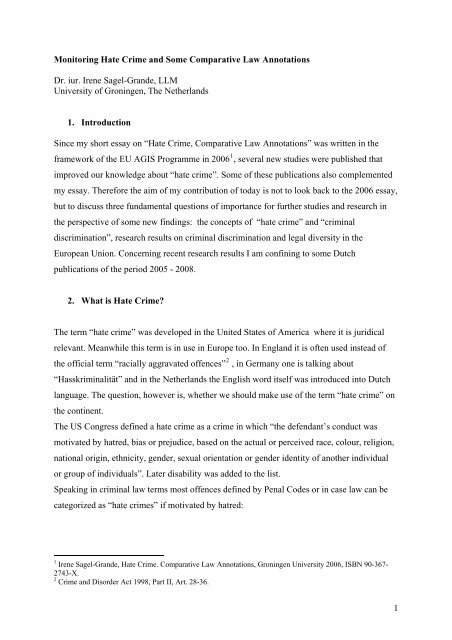

![AGIS2 Nov 08 Conference Report_[Version 2] - CEP, the European ...](https://img.yumpu.com/50764570/1/190x245/agis2-nov-08-conference-report-version-2-cep-the-european-.jpg?quality=85)
